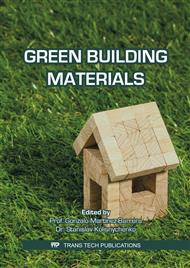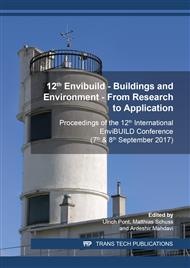[1]
J. Fricke, U. Heinemann, H.P. Ebert, Vacuum insulation panels – From research to market, J. Vacuum. 82 (2008) 680-690.
DOI: 10.1016/j.vacuum.2007.10.014
Google Scholar
[2]
Gervais PP, Goumy D, US patent 4,159,359. (1979).
Google Scholar
[3]
W. Fischer, W. Haar, PhuZ, 9 (1978), 184–191.
Google Scholar
[4]
R. Caps, J. Fricke, H. Reis, High Temps—High Press, 15 (1983) 225–232.
Google Scholar
[5]
R. Baetens, B. P. Jelle, J. V. Thue, M. J. Tenpierik, S. Grynning, S. Uvsløkk, A. Gustavsen, Vacuum insulation panels for building applications: A review and beyond, J. Energy and Buildings. 42 (2010) 147–172.
DOI: 10.1016/j.enbuild.2009.09.005
Google Scholar
[6]
P. Johannson, S. Geving, C. E. Hagentoft, B. P. Jelle, E. Rognvik, A. S. Kalagasidis, B. Time, Interior insulation retrofit of a historical brick wall using vacuum insulation panels: Hygrothermal numerical simulations and laboratory investigations, J. Build and Envir 79 (2014) 31-45.
DOI: 10.1016/j.buildenv.2014.04.014
Google Scholar
[7]
P. Johannson, C. E. Hagentoft, A. S. Kalagasidis, Retrofitting of a listed brick and wood building using vacuum insulation panels on the exterior of the facade: Measurements and simulations, J. Energy and Build 73 (2014) 92-104.
DOI: 10.1016/j.enbuild.2014.01.019
Google Scholar
[8]
S. Brunner, K. G. Wakili, T. Stahl, B. Binder, Vacuum insulation panels for building applications—Continuous challenges and developments, J. Energy and Build 85 (2014) 592-596.
DOI: 10.1016/j.enbuild.2014.09.016
Google Scholar
[9]
X. Di, Y. Gao, Ch. Bao, S. Ma, Thermal insulation property and service life of vacuum insulation panels with glass fiber chopped strand as core materials, J. Energy and Build 73 (2014) 176-183.
DOI: 10.1016/j.enbuild.2014.01.010
Google Scholar
[10]
I. Mandilaras, I. Atsonios, G. Zannis, M. Founti, Thermal performance of a building envelope incorporating ETICS with vacuum insulation panels and EPS, J. Energy and Build 85 (2014) 654-665.
DOI: 10.1016/j.enbuild.2014.06.053
Google Scholar
[11]
P. Mukhopadhyaya, D. MacLean, J. Korn, D. van Reenen, S. Molleti, Building application and thermal performance of vacuum insulation panels (VIPs) in Canadian subarctic climate, J. Energy and Build 85 (2014) 672-680.
DOI: 10.1016/j.enbuild.2014.08.038
Google Scholar
[12]
F. E. Boafo, Z. Chen, Ch. Li, B. Li, T. Xu, Structure of vacuum insulation panel in building system, J. Energy and Build 85 (2014) 644-653.
DOI: 10.1016/j.enbuild.2014.06.055
Google Scholar
[13]
S. Park, B. H. Choi, J. H. Lim, S. Y. Song, Evaluation of Mechanically and Adhesively Fixed External Insulation Systems Using Vacuum Insulation Panels for High-Rise Apartment Buildings, J. Energies 7 (2014) 5764-5786.
DOI: 10.3390/en7095764
Google Scholar
[14]
E. C. Hammond, J. A. Evans, Application of Vacuum Insulation Panels in the cold chain e Analysis of viability, Int. J. of Refrigeration 47 (2014) 58-65.
DOI: 10.1016/j.ijrefrig.2014.07.010
Google Scholar
[15]
H. Jung, I. Yeo, T. H. Song, Al-foil-bonded enveloping and double enveloping for application to vacuum insulation panels, J. Energy and Build 84 (2014) 595-606.
DOI: 10.1016/j.enbuild.2014.08.045
Google Scholar
[16]
V. Nemanič, M. Žumer, New organic fiber-based core material for vacuum thermal insulation, J. Energy and Build 90 (2015) 137-141.
DOI: 10.1016/j.enbuild.2015.01.012
Google Scholar
[17]
J. Véjeliené, Impact of technological factors on the structure and properties of thermal insulation materials from renewable resources, Doctor dissertation, Vilnius Gediminas Technical University, Lithuania (2012).
Google Scholar
[18]
J. Véjeliené, A. Gailius, S. Vejelis, et al., Evaluation of Structure Influence on Thermal Conductivity of Thermal Insulating Materials from Renewable Resources, Materials Science-Medziagotyra, National Conference on Materials Engineering, 17 (2011) 208-212.
DOI: 10.5755/j01.ms.17.2.494
Google Scholar
[19]
A. Kljun, H. M. E. Dessouky, T. A. S. Benians, F. Goubet, F. Meulewaeter, J. P. Knox, R. S. Blackburn, Analysis of the physical properties of developing cotton fibres, J. European Polymer, 51(2014) 57-68.
DOI: 10.1016/j.eurpolymj.2013.11.016
Google Scholar
[20]
EN 822 Thermal insulating products for building applications. Determination of length and width.
Google Scholar
[21]
EN 12085 Thermal insulating products for building applications. Determination of linear dimensions of test specimens.
DOI: 10.3403/01188288u
Google Scholar
[22]
EN 823 Thermal insulating products for building applications. Determination of thickness.
Google Scholar
[23]
EN 1602 Thermal insulating products for building applications. Determination of the apparent density.
Google Scholar
[24]
EN 12667 Thermal performance of building materials and products. Determination of thermal resistance by means of guarded hot plate and heat flow meter methods. Products of high and medium thermal resistance.
DOI: 10.3403/02109602u
Google Scholar
[25]
ISO 8301 Thermal insulation -- Determination of steady-state thermal resistance and related properties -- Heat flow meter apparatus.
Google Scholar



